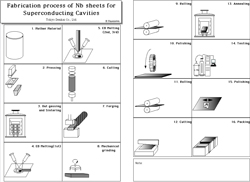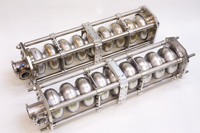 |
 |
|||||||||||||
|
|||||||||||||
|
|||||||||||||
|
The ILC will have an ultra-cold and complex heart made of niobium, a rare, soft, grey, and ductile transition metal. Some 18,000 radio frequency (RF) accelerating cavities for the ILC will be made of niobium, which becomes superconductor when cooled to nearly absolute zero. The global annual production of niobium in 2007 was 58,000 tonnes, and it is expected to grow up to 45 percent more in 2010 with a positive trend towards economic recovery. Although it is a 'rare' material, the reserves of niobium are assumed to be enough to cover the current world demand for 500 years – well enough to supply the ILC cavities and many other projects which uses or will use niobium-based superconducting RF systems such as Fermilab's Project X in the US, Europe's XFEL at DESY in Germany, energy-recovering linear accelerators driving fourth-generation light sources, such as the compact ERL at KEK in Japan or Jefferson Lab's free-electron laser in the US, Oak Ridge National Laboratory's Spallation Neutron Source, accelerator-driven systems for nuclear power production in India, the facility for Rare Isotope Beams, and compact accelerators for university laboratories or hospitals. OK, the amount is enough. But the quality of the niobium is a different question. Niobium has been used as an additive to steel because it is effective in stabilising carbon in steel and prevents the progression of corrosion among particles. The largest part is used in alloys, especially for an alloy of niobium and iron called ferro-niobium being used for oil and gas pipelines, or steel beam for large-scale buildings. However, the alloys contain just a small amount of niobium: only a maximum of 0.1 percent can improve the strength of the steel drastically. “The ILC is a very special market for high-purity niobium”, says Hiroaki Umezawa from Tokyo Denkai, one of the three companies in the world capable of a steady production of high-quality niobium that meets the ILC requirements. He made a presentation at a satellite workshop on ILC cavity industrialisation held in conjunction with the first IPAC meeting last month in Kyoto, Japan. “The residual resistivity ratio (RRR) is the most important number to ensure the quality of the purified niobium. The ILC requires the RRR whereas no other market does,” Umezawa said. “Through R&D with KEK scientists, we found that a niobium with least containment of tantalum is ideal for superconducting cavities.” Niobium and tantalum share very similar physical and chemical properties, so many chemists thought they were identical elements until in the middle of 1800's, when chemists proved that niobic and tantalic acids were two different things. They are so similar that their names came from relatives in the Greek mythology: Tantalos is Niobe's father. But the father and the daughter seem to not get along very well as a superconducting cavity. Niobium is usually heat-treated to purify – melt down repeatedly in a furnace to distill the impurities. But tantalum has a higher melting point than niobium, so the method does not work. “Most of the companies don't bother separating niobium and tantalum, because there are not enough demands in the market. Only one company in Estonia can supply the ore with the quality we want,” Umezawa explaining that no principle of competition works here. Lack of demand also influences the number of companies that are equipped with the furnaces. “The market for very pure niobium is too small to encourage newcomers to join this field. If we received the order to process niobium for all ILC cavities at one time, there would be no way for us to handle it with a capability of only three companies.” There is another technological hurdle for newcomers' access to the market in niobium sheet production process. “Niobium is so soft, that rolling it out evenly is not as simple as one can imagine,” said Umezawa. “To tell the truth, seeking high-purity niobium is not a profitable job. But the biggest advantage for us to work on ILC R&D is that we can get at one of the most-advanced technology,” said Umezawa. Scientists and industries in the world are seeking alternative way to process niobium towards the ILC. “The higher the hurdle, the better our technological capability becomes.” -- Rika Takahashi |
|||||||||||||
| © International Linear Collider |

